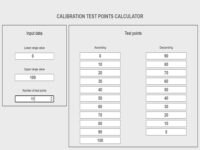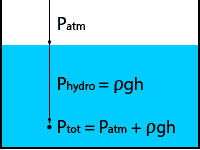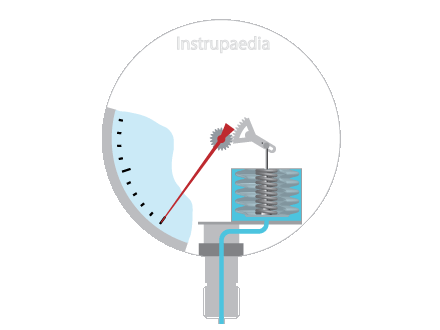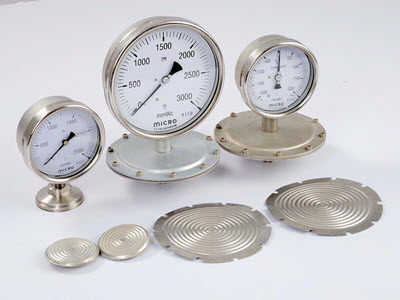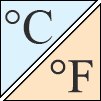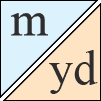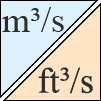Terminology
Definitions of technical terms used in instrumentation
A
Absolute pressure gauge+
 An absolute pressure gauge is a device that displays pressure which is always referenced to a perfect vacuum. The pointer indicates a perfect vacuum when it is positioned at the zero mark. Absolute pressure is the sum of atmospheric pressure and gauge pressure.
An absolute pressure gauge is a device that displays pressure which is always referenced to a perfect vacuum. The pointer indicates a perfect vacuum when it is positioned at the zero mark. Absolute pressure is the sum of atmospheric pressure and gauge pressure.
The illustration is showing a pressure gauge disconnected from the process, measuring atmospheric pressure.
Accuracy+
Accuracy is the maximum difference between the value indicated by the sensor and the actual value. The accuracy can be indicated as a percentage of full scale or as an absolute value. It should take into account all possible errors that may occur during measurement such as linearity, repeatability, resolution, hysteresis, zero temperature coefficient, gain temperature coefficient, long term stability and calibration errors.
Adjustable pointer+
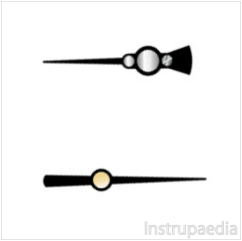 A pointer with an adjustment screw, accessible through the dial, for zero correction.
A pointer with an adjustment screw, accessible through the dial, for zero correction.
The illustration is showing an adjustable pointer on top and a non-adjustable pointer below.
B
Backlash+
Backlash is the play or lost motion, resulting from loose connections between interacting mechanical parts, when motion is reversed.
Baffle wall+
A metal plate designed to protect the glass window of a pressure gauge against a sudden pressure build-up in the casing as a result of a failure of the pressure-responsive element.
Barometer+
An instrument which is used to measure atmospheric pressure.
Burst pressure+
Burst pressure is the maximum pressure that may be applied to the sensor without causing catastrophic failure of the sensor.
C
Compound pressure gauge+
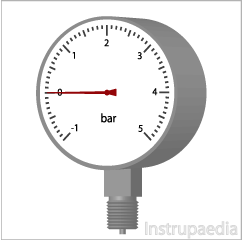 A compound gauge is a device that can display both positive and negative (vacuum) pressures. The reference pressure will always be atmospheric pressure. The pointer of such pressure gauges will be on the zero mark when atmospheric pressure is measured and rotate counterclockwise when the process pressure is a vacuum. The rotation will be clockwise when the pressure rises up to the atmospheric pressure and above.
A compound gauge is a device that can display both positive and negative (vacuum) pressures. The reference pressure will always be atmospheric pressure. The pointer of such pressure gauges will be on the zero mark when atmospheric pressure is measured and rotate counterclockwise when the process pressure is a vacuum. The rotation will be clockwise when the pressure rises up to the atmospheric pressure and above.
The illustration is showing a pressure gauge disconnected from the process, measuring atmospheric pressure.
Concave+
Having a surface that is curved or rounded inward, like the inside of a bowl.
Convex+
Having a surface that is curved or rounded outward, like the outside of a bowl.
Creep+
Creep is a slow deformation of solid material due to continuous exposure to mechanical stress, even when the stress level is below the yield strength of the material. The deformation remains permanently.
D
Dead spaces+
These are places where the process medium is standing still and rarely or never renewed. In such places, germs or bacteria can accumulate and become a real hotbed with an infection of the process medium as a result.
Dead Time+
Dead Time is the amount of time the transmitter takes to initially respond to the change in input value.
Dielectric constant+
Also known as relative permittivity. It is, for each kind of dielectric material, a dimensionless factor that indicates how many times the electric field between the plates is smaller in relation to vacuum.
Differential pressure gauge+
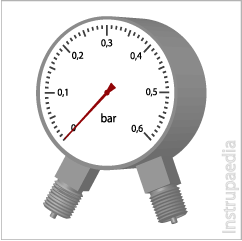 A differential pressure gauge is a device that compares two pressures and displays the resulting pressure. It has two inlet ports, each connected to one of the volumes whose pressure is to be monitored.
A differential pressure gauge is a device that compares two pressures and displays the resulting pressure. It has two inlet ports, each connected to one of the volumes whose pressure is to be monitored.
The illustration is showing a pressure gauge disconnected from the process, measuring atmospheric pressure at both ports.
DPDT+
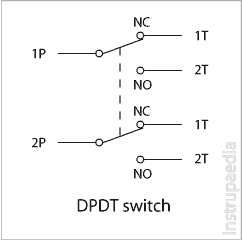 Double-pole double-throw switches are composed of two SPDT switches which are mechanically connected. They always switch simultaneously. They have two inputs and four outputs.
Double-pole double-throw switches are composed of two SPDT switches which are mechanically connected. They always switch simultaneously. They have two inputs and four outputs.
Drift+
Drift is a progressive change of the indication or output of a measurement over an extended period of time with unchanged environmental conditions, during which the actual value of the measured quantity remains the same. It can be indicated as a percentage of span or reading per unit of time.
Duplex pressure gauge+
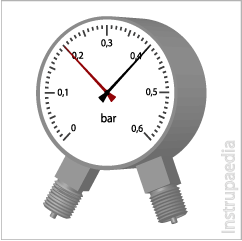 A duplex pressure gauge is a device that measures two different pressures and/or vacuum values by means of two separate pressure-responsive elements in one case, each of which drives its own pointer. The left connector operates the black pointer while the right one operates the red pointer.
A duplex pressure gauge is a device that measures two different pressures and/or vacuum values by means of two separate pressure-responsive elements in one case, each of which drives its own pointer. The left connector operates the black pointer while the right one operates the red pointer.
E
Elastic limit+
The elastic limit or yield point is the point at which a material starts to deform plastically when it is subjected to stress. Below the elastic limit, the material will deform elastically and will return to its original shape when the applied stress is removed. A material which is subjected to stress above the elastic limit will experience a permanent, irreversible deformation.
F
Fatigue life+
Fatigue is the weakening of a material when exposed to cyclic loads. The number of stress cycles that a specimen sustains before failure is called the fatigue life.
Flush diaphragm+
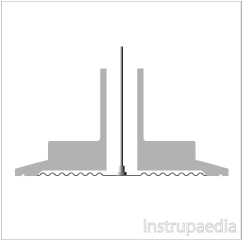 A diaphragm that is located on the very tip of the measuring device.
A diaphragm that is located on the very tip of the measuring device.
Flying leads+
When a sensor is provided with a cable with loose wires at the end of the cable, these wires are called flying leads.
Fully developed flow profile+
 A fully developed flow profile is free from swirls or vortices and is characterized by being symmetrical along the center of the duct, being rather flat, but falling towards zero in the vicinity of the duct wall, and (in a circular duct) having a flow equal to the average flow at a distance of 12% of the diameter from the duct wall.
A fully developed flow profile is free from swirls or vortices and is characterized by being symmetrical along the center of the duct, being rather flat, but falling towards zero in the vicinity of the duct wall, and (in a circular duct) having a flow equal to the average flow at a distance of 12% of the diameter from the duct wall.
A fully developed profile is typically achieved with a long distance of straight pipe downstream of any disturbance or bend in the duct, and with a rather high Reynolds number.
G
Gravity of Earth+
Denoted by g, it is the acceleration by which objects fall to the Earth in free fall, so if there are no other forces at work than the force of gravity.
H
Hastelloy C-276+
HASTELLOY C-276 is a Ni-Cr-Mo-W-alloy which is generally considered to be very versatile corrosion resistant alloy. It has a very good corrosion resistance at high and low temperatures in both oxidizing and reducing environments.
Hysteresis+
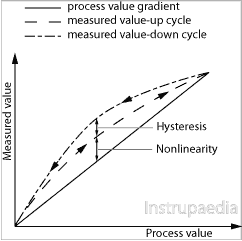 Hysteresis is the difference in output value between the measured value during the up cycle and the measured value during the down cycle for the same process value.
Hysteresis is the difference in output value between the measured value during the up cycle and the measured value during the down cycle for the same process value.
I
Impedance+
Impedance is a measure of the total opposition that a circuit presents to electric current. Impedance includes both resistance and reactance. The resistance component arises from collisions of the electrons with the internal structure of the conductor. The reactance component is an additional opposition to the movement of electric charge that arises from the changing magnetic and electric fields in circuits carrying alternating current.
J
K
L
Line pressure effect+
See ‘Static pressure effect’
Linearity+
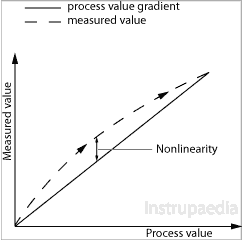 The linearity of a sensor indicates to what extent the measured curve is consistent with the ideal curve. The better the linearity, the more the measured curve follows the ideal curve. Perfect linearity would mean that the output is directly proportional to the input over its entire range. Often, non-linearity is specified instead of linearity.
The linearity of a sensor indicates to what extent the measured curve is consistent with the ideal curve. The better the linearity, the more the measured curve follows the ideal curve. Perfect linearity would mean that the output is directly proportional to the input over its entire range. Often, non-linearity is specified instead of linearity.
Long-term stability+
Long term stability is a measure of how much the output signal will drift over time under normal operating conditions.
M
Maximum pointer+
A secondary pointer driven by the pointer which stays at the maximum value reached by the latter. Maximum pointers may add an additional ±1% error to the gauge because of the increased load on the pressure-responsive element, especially at small measuring ranges. After the pressure has returned to a normal level, the maximum pointer needs to be reset manually.
N
Needle valve+
A needle valve is made for precise regulations of low flow rates. This small valve is made of a needle-shaped stem which is lowered through the seat to restrict or block flow.
Negative pressure+
Also called underpressure or vacuum pressure, is a relative pressure smaller than the pressure surrounding the gauge, usually atmospheric pressure, using the ambient pressure as a reference.
Nonlinearity+
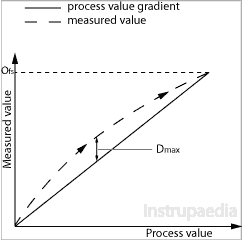 The nonlinearity of a sensor is the maximum deviation, over the entire measurement range, of the measured curve compared to the ideal curve. Nonlinearity is defined as follows:
The nonlinearity of a sensor is the maximum deviation, over the entire measurement range, of the measured curve compared to the ideal curve. Nonlinearity is defined as follows:
Nonlinearity(%) = 
Where:
Dmax = maximum output deviation
Ofs = full scale output
O
Offset+
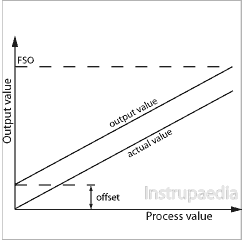 Offset is the output value of a transmitter when the actual value is zero.
Offset is the output value of a transmitter when the actual value is zero.
Overpressure+
Related to pressure measurements, this is a pressure higher than the full range pressure of the instrument.
P
Photolithographic techniques+
A process used in microfabrication. A silicon substrate is covered with a photoresist material and is then exposed to a pattern of intense light. As a result, certain parts of the photoresist material will become liquid and the underlying silicon substrate of these parts can be etched away by means of chemical agents.
Piezoresistance effect+
The piezoresistance effect is a change in the electrical resistivity of a semiconductor or metal when mechanical strain is applied.
Pitch angle+
 In pitot tube flow measurement, the pitch angle is the angle between the centerline of the pipe and the pitch component of the flow vector.
In pitot tube flow measurement, the pitch angle is the angle between the centerline of the pipe and the pitch component of the flow vector.
From the standpoint of a tester facing a test port in a vertical pipe, the pitch component of flow is the vector of flow moving from the center of the pipe toward or away from that test port.
Polarization+
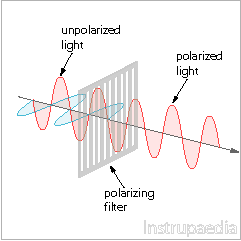 Light waves can be thought of as electromagnetic waves vibrating in multiple planes. These kinds of light waves are referred to as unpolarized light. There are various methods for unpolarized light to be converted into polarized light. Polarized light consists of electromagnetic waves vibrating in a single plane. The conversion process from unpolarized light to polarized light is called polarization.
Light waves can be thought of as electromagnetic waves vibrating in multiple planes. These kinds of light waves are referred to as unpolarized light. There are various methods for unpolarized light to be converted into polarized light. Polarized light consists of electromagnetic waves vibrating in a single plane. The conversion process from unpolarized light to polarized light is called polarization.
Positive pressure+
Also called overpressure, is a relative pressure greater than the pressure surrounding the gauge, usually atmospheric pressure, using the ambient pressure as a reference.
Precision+
 Precision is the degree of reproducibility of a sensor output value for the same actual value if all conditions remain the same and the measurements are repeated over a short period of time. The repeatability coefficient is a measurement of precision.
Precision is the degree of reproducibility of a sensor output value for the same actual value if all conditions remain the same and the measurements are repeated over a short period of time. The repeatability coefficient is a measurement of precision.
Pressure-responsive element+
An elastic element which undergoes deformations under the effect of pressure variations. It may be a Bourdon tube, diaphragm, diaphragm capsule, bellows or other type of element.
Process wetted parts+
All parts of a measuring device that come in direct contact with the process medium.
Q
R
Range+
The range of a sensor is the interval between the minimum and maximum values within which the sensor is able to measure.
Rated pressure+
Rated pressure is the maximum pressure, applied to a sensor, to which the specifications of the sensor remain guaranteed. Also called the static pressure limit.
Readability+
Some of the factors that influence the readability are:
- distance between observer and indication
- illumination
- distance between de pointer and the dial
- constant fluctuation between two digits in the display
- vibration of the pointer
Reluctance+
Reluctance is the resistance to magnetic flux in a magnetic circuit. It is comparable with resistance to current in an electric circuit.
Repeatability+
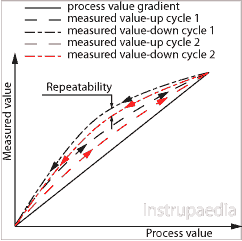 Repeatability is the degree to which a sensor is able to reproduce the same output value for an unchanged process value when all conditions remain the same, and the measurements are repeated over a short period of time.
Repeatability is the degree to which a sensor is able to reproduce the same output value for an unchanged process value when all conditions remain the same, and the measurements are repeated over a short period of time.
Resolution+
Resolution is the smallest difference in actual value which can be measured by the sensor.
Resonant frequency+
Every object has its own natural frequency. When an object is subjected to vibrations at a frequency equal to its natural frequency, it will start to oscillate at its largest amplitude. The vibration frequency at which this phenomenon occurs is called the resonant frequency.
Response time+
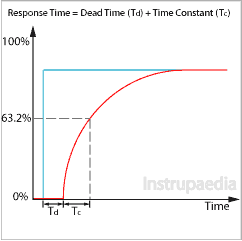 The time it takes for a sensor to change his output from a previous state to the new steady-state value when subjected to a rising step input. Typically the response time will be given as the time needed to reach 63.2% of steady state output upon exposure to a unit step change in input. The response time is a measure for the inertia of a device and consists of two components, Dead Time and the Time Constant.
The time it takes for a sensor to change his output from a previous state to the new steady-state value when subjected to a rising step input. Typically the response time will be given as the time needed to reach 63.2% of steady state output upon exposure to a unit step change in input. The response time is a measure for the inertia of a device and consists of two components, Dead Time and the Time Constant.
S
Sensitivity+
The sensitivity of a sensor is defined as the change in the output of the sensor per unit change of the parameter being measured. The factor may be constant over the range of the sensor (linear), or it may vary (nonlinear).
Snubber+
A snubber is a device used to create an adjustable restriction in the pipe with the intention to suppress rapid pressure transients.
Span+
The arithmetic difference between the highest and the lowest value of the measuring range.
Example: The range of a temperature transmitter is set between -20°C and +70°C.
The span is then 90°C.
SPDT+
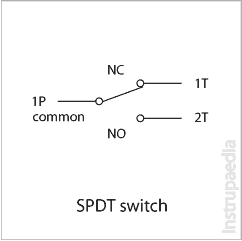 Single-pole double-throw switches are made of a normally open (NO) and a normally closed (NC) contact. They have one input and two outputs. Only one pole can be connected to the common pin. The electric current can be switched to one direction or the other.
Single-pole double-throw switches are made of a normally open (NO) and a normally closed (NC) contact. They have one input and two outputs. Only one pole can be connected to the common pin. The electric current can be switched to one direction or the other.
SPST+
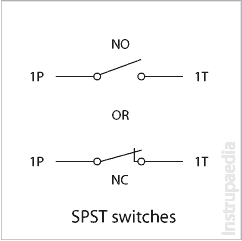 Single-pole single-throw switches exist in two types: normally open (NO) and normally closed (NC) switches when de-energized. They have one input and one output. Only one pole can be connected. The electric current can only be passed through or be interrupted.
Single-pole single-throw switches exist in two types: normally open (NO) and normally closed (NC) switches when de-energized. They have one input and one output. Only one pole can be connected. The electric current can only be passed through or be interrupted.
Standard atmospheric pressure+
Is a standardized value of the air pressure at sea level, which was determined to be 1013.25 mbar at 15 °C in metric units and 14.696 psi at 59 °F in imperial units. Some organizations may also use other standards.
Static pressure effect+
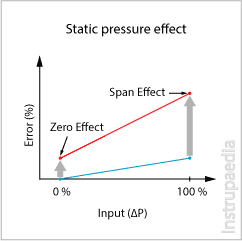 Also called line pressure effect. It is the effect of line pressure applied to both the high and low ports of a differential pressure transmitter. Changes in static process pressure cause minor stress changes in the sensor’s mechanical structure. Since the sensing diaphragm is connected to this mechanical structure, it will also be exposed to these stresses, causing a slight diaphragm deflection. This will result in a change in the calibration of the transmitter. Both the zero and the span of the transmitter are affected. On high process pressure systems, the span error will be greater than the zero error. A typical value for the static pressure effect is 0.25% of the upper range limit for 2000 psig (138 barg) line pressure.
Also called line pressure effect. It is the effect of line pressure applied to both the high and low ports of a differential pressure transmitter. Changes in static process pressure cause minor stress changes in the sensor’s mechanical structure. Since the sensing diaphragm is connected to this mechanical structure, it will also be exposed to these stresses, causing a slight diaphragm deflection. This will result in a change in the calibration of the transmitter. Both the zero and the span of the transmitter are affected. On high process pressure systems, the span error will be greater than the zero error. A typical value for the static pressure effect is 0.25% of the upper range limit for 2000 psig (138 barg) line pressure.
Static pressure limit+
Static pressure limit is the maximum pressure, applied to a sensor, to which the specifications of the sensor remain guaranteed. Also called the rated pressure.
T
Tantalum+
Tantalum is a metal which is almost completely immune to chemical attack at temperatures below 150°C, with the exception of substances such as hydrofluoric acid, acidic solutions containing the fluoride ion, and free sulphur trioxide.
Temperature effect+
Temperature effect on pressure sensors is the inaccuracy of the output signal resulting from a change in temperature of the measured medium or the environment around the sensor. It is expressed in percentage of the span for a certain amount of temperature change within this range. The calibration temperature is used as the starting point for calculating the error.
Pressure sensors are sensitive to changes in temperature, especially when this change occurs quickly. Within a specified temperature range, the effect can be compensated electronically. Measurements outside this compensated temperature range may show inaccuracies up to 3 times the compensated range error.
Tensile strain+
Strain is the amount of deformation of an object as a result of stress.
Tensile strain = extension / original length
The opposite of tensile strain is called compressive strain.
Time constant+
The time constant is part of the response time and describes how fast a sensor responds to a change in input signal. The time constant consists of mechanical and electronic response time. Mechanical response time is the time it takes for the process parameter change to be transmitted to the sensor. Electronic response time is the time from the sensor detecting the process parameter change to the transmitter electronics producing an output signal.
U
V
Vacuum gauge+
 A vacuum gauge is a device that displays negative (vacuum) pressure. The reference pressure will always be atmospheric pressure. The pointer of such pressure gauges will be on the zero mark (at the right end of the scale) when atmospheric pressure is measured and rotate counterclockwise when the process pressure is a vacuum.
A vacuum gauge is a device that displays negative (vacuum) pressure. The reference pressure will always be atmospheric pressure. The pointer of such pressure gauges will be on the zero mark (at the right end of the scale) when atmospheric pressure is measured and rotate counterclockwise when the process pressure is a vacuum.
The illustration is showing a pressure gauge disconnected from the process, measuring atmospheric pressure.
W
X
Y
Yaw angle+
 In pitot tube flow measurement, the yaw angle is the angle between the centerline of the pipe and the yaw component of the flow vector when the probe is rotated.
In pitot tube flow measurement, the yaw angle is the angle between the centerline of the pipe and the yaw component of the flow vector when the probe is rotated.
From the standpoint of a tester facing a test port in a vertical pipe, the yaw component of flow is the vector of flow moving to the left or right from the center of the pipe as viewed by the tester.
Young’s modulus+
Young’s modulus, also known as the elastic modulus, is a measure of the stiffness of a solid material.





